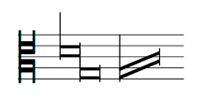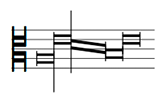5.1. Note and Rest Values 5.1.1. Actual Duration with Alterations and Imperfections 5.2. Mensuration Signs 5.3. Proportions 5.4. Ligatures 5.5. Music Data Organization 5.6. Notation Types
5. Repertoire: Mensural Notation
This chapter describes the module for encoding mensural notation from the late 13th century to about 1600. Historically, mensural notation preceded the development of Common Music Notation (CMN) and it included a wide range of features that persist in CMN and that can be encoded in a standard manner in MEI. In mensural notation, pitches are notated as in CMN, leaving out here the major exception of musica ficta. The pitch is given by the position of the note on the staff and the current clef as in CMN, and the mensural module introduces no modification to MEI regarding how pitches are encoded.
There are a certain number of differences, however, regarding the representation of duration in mensural notation. The mensural module introduces specific attribute values for notes and rests for appropriately encoding mensural durations. One of the main particularities is that the actual duration of a note is not given only by its symbol but also by position and the context in which the symbol appears. The general context is given by one of the 16 mensural species provide four levels of division: modus major, modus minor, tempus and prolatio. Depending on the context, certain rules must be applied in order to determine the duration of a note. In these cases, encoding both the sign and its actual duration is highy desirable.
Another particularity of mensural notation is the use of proportions that are indicated by numeric proportions or by specific mensuration signs. The proportions indicate that the durations have to be modified accordingly and they can be combined in a very complex manner. Over time, proportions and mensuration signs were simplified and became time signatures in CMN. The attributes and elements that are necessary for encoding proportions and mensural signs are made available by the module.
In mensural notation, notes can also be notated in ligatures that regroup two or more notes. Ligatures were a legacy from an earlier notation system that were still widely used in Renaissance music notation. They gradually disappeared during the seventeenth century. The mensural module provides multiple ways of encoding the ligatures.
5.1. Note and Rest Values
When the mensural module is included, @dur on note, rest, and other elements can take the following values:
- maxima
- longa
- brevis
- semibrevis
- minima
- semiminima
- fusa
- semifusa
5.1.1. Actual Duration with Alterations and Imperfections
In ternary divisions, the dichotomy between the duration sign of the notes and their actual duration requires specific attention. The rules of mensural notation can require the alteration or the imperfection of a note; that is, an increase or reduction in its performed duration. In these cases, if the encoding is intended to be suitable for more than just graphically representing the notation, encoding only the duration of the sign can quickly become insufficient. It that case, it is recommended to encode the sign in the @dur attribute and its performed duration using the @num and @numbase attributes.
The following example illustrates an alteration (the second brevis) in modus minor perfectus and tempus imperfectum. The performed duration of each note is given as a proportion of a whole note using the @num and @numbase:
<layer>
<note dur="longa" num="6" numbase="1"></note>
<note dur="brevis" num="2" numbase="1"></note>
<note dur="brevis" num="4" numbase="1"></note>
<note dur="longa" num="6" numbase="1"></note>
</layer>The following example illustrates an imperfection (the two longae) in modus minor perfectus and tempus perfectum with the same longa-brevis-brevis-longa sequence but with an additional punctus divisionis between the two breves:
<layer>
<note dur="longa" num="6" numbase="1"></note>
<note dur="brevis" num="3" numbase="1"></note>
<dot form="div"></dot>
<note dur="brevis" num="3" numbase="1"></note>
<note dur="longa" num="6" numbase="1"></note>
</layer>5.2. Mensuration Signs
Using the mensural module, mensuration signs can be indicated with the attributes available on the scoreDef and staffDef elements. Mensuration signs encoded using attributes on scoreDef are regarded as default values which may be overridden by values attached to individual staffDef elements.
The division levels corresponding to modus maior, modus minor, tempus, and prolatio can be encoded in the @modusmaior, @modusminor, @tempus, and @prolatio attributes respectively. Their value must be 3 (perfect) or 2 (imperfect).
The mensur signs themselves can be encoded in the @mensur.sign attribute with a possible value of “C” or “O”. Its orientation can be encoded in the @mensur.orient attribute, for example, with the value “reversed” for a flipped C sign. The number of slashes (up to 6) can be given in the @mensur.slash attribute. There is also a @mensur.dot attribute for indicating the presence of a dot through the boolean values “true” or “false”.
mensur elements can also be used instead of staffDef and its attributes. In mensur, the division levels are encoded with the same @modusmaior, @modusminor, @tempus, and @prolatio attributes, while the attributes to indicate the mensur signs are: @sign, @orient, @slash, and @dot.
5.3. Proportions
Proportions can also be indicated within the staffDef element. The @proport.num and @proport.numbase attributes are available for encoding the numerator and the denominator of the proportion, respectively. There is also a proport element that can be used as an alternative, with the corresponding @num and @numbase attributes.
5.4. Ligatures
Ligatures can be encoded using the ligature element. The @form attribute is available for specifying if the ligature is recta or obliqua.

<layer>
<ligature form="recta">
<note dur="semibrevis" oct="4" pname="d"></note>
<note dur="semibrevis" oct="3" pname="g"></note>
</ligature>
<ligature form="obliqua">
<note dur="semibrevis" oct="3" pname="g"></note>
<note dur="semibrevis" oct="4" pname="c"></note>
</ligature>
</layer>In cases where the ligature contains both recta and obliqua notes, the @lig attribute of the note element can be used to specify the form of the ligature at the note level.

<ligature form="recta">
<note dur="longa" oct="3" pname="a"></note>
<note dur="longa" oct="4" pname="e"></note>
<note dur="semibrevis" lig="obliqua" oct="4" pname="d"></note>
<note dur="semibrevis" lig="obliqua" oct="4" pname="c"></note>
<note dur="brevis" oct="3" pname="b"></note>
<note dur="brevis" oct="4" pname="e"></note>
</ligature>5.5. Music Data Organization
The data organization based on measure elements that usually prevails in MEI is not appropriate for mensural notation because most music until 1600 was written in a non-measured manner. Even though it is not defined by the mensural module, a more suitable alternate data organization without measures is available: staff elements may occur directly within the section element without being organized into measures first. The organization of events (notes, rests, etc.) within the staff and layer elements remains unchanged.
<section>
<staff n="1">
<layer>
<note dur="longa" oct="5" pname="c"></note>
<note dur="brevis" oct="4" pname="g"></note>
<note dur="brevis" oct="4" pname="e"></note>
</layer>
</staff>
<staff n="2">
<layer>
<note dur="maxima" oct="3" pname="c"></note>
</layer>
</staff>
</section>This feature may also be used to encode measured music without using the measure element. That is, the same data organization described above may be used, but with the addition of barlines, indicated by the barLine element, for those situations where a measure-by-measure organization is not appropriate, for exampe, when measures are not coincident in all the staves of a score.
5.6. Notation Types
The @notationtype attribute, part of the MEI module, can be used within the staffDef element to specify which dialect of mensural notation is in use. At the moment, three values are in use for mensural notation: “mensural”, “mensural.black”, and “mensural.white”. The values of the @notationtype attribute can indicate notation types other than mensural, such as common (Western) music notation, neume notation, and tablature.
The attribute @notationsubtype can be used, together with the @notationtype attribute, to provide more specificity regarding the type of notation encoded. This attribute can be used, for example, to specify if a piece in black mensural notation (notationtype = “mensural.black”) is written in Ars antiqua or Ars nova style. Currently, the values allowed in the @notationsubtype attribute consist of any sequence of characters provided by the user.
Important: An element with a @notationsubtype attribute must have a @notationtype attribute.